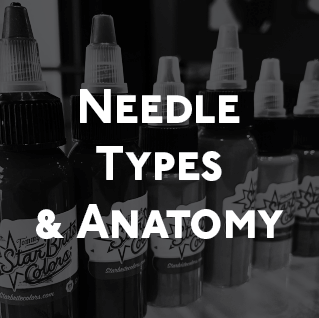
February 11, 2023
Stick ’em with the Pointy End: Needle Types and Anatomy
Ever wonder why your tattoo artist has several needles out and ready to go for you tattoo session? Well, we’re here to explain it! As like many art forms, tattooing requires different tools to achieve an awesome end result. Painters use a wide variety of paint brushes to paint a picture. Similarly, tattoo artist uses a variety of needle types to put ink your skin.
Attributes of Needles
There are three main attributes of needles other than basic configuration of the pins. The first is the diameter of the needle. The second is the taper. And the third is the needle count.
Diameter
The diameter of a needle affects ink flow and puncture of the skin. A needle with a more narrow diameter provides a more controlled release of ink and finer, more delicate linework. Subsequently, larger diameters allow the ink to flow more freely, and may be better for shading or coloring.
The most common needle diameters are as follows.
- #06 – 0.20mm
- #08 – 0.25mm
- #10 – 0.30mm
- #12 – 0.35mm
#12’s are considered the most popular and are referred to as “Standards.” Any diameter under #10’s are referred to as bug pins. Bug pins are great for linework and precise shading and dot work.
Taper Lengths
Taper lengths have to do with the length at the end of the needle which comes to a point. A shorter taper with have a short point. Subsequently, a long taper will have a longer point. No matter how long or short a taper is, it does not affect how deep the needle goes into ones skin. Instead, it influences the amount of ink coming out of the needle and how fast. The longer the taper, the slower and more controlled the ink flow is. A shorter taper will dispense ink quickly and more of it. Short taper is good for bold thick lines where as a long taper works well for finelines.
Needle Count
The needle count refers to the number of pins within the cartridge or traditional needle configuration. The higher the number, the more surface area is covered.
Needle Configurations
There are many configurations for needles, and each provide something different for the artist. Some needles are used for lining, others are for shading or packing color. But some needles can do both!
Round Liners
Round liners are configured into circular groupings of needles. The are clustered into a point. This allows for precise lining.
Hollow Liners
Hollow liners are similar to round liners. However, the center is hollow, meaning there’s no center to the needle. This allows for longer ink flow and crisp linework.
Round Shaders
Round shaders are also circular clusters of needles. But they have more space between each pin unlike round liners. They create thick, bold lines and are useful for filling and shading.
Flat
Flat Magnums have needles positioned together into a straight line. They are easy to angle and hold a lot of ink. They are good for tattoos with sharp angles.
Magnum
Magnums are similar to flats in configuration. However, they have two rows of needles stack on each other. This covers a wider range of skin and good for heavy color packing. They are also particularly useful for large scale shading.
Stacked Magnums
Similarly, stacked magnums are configured in two rounds but the pins are packed closer together. This provides strong color saturation.
Curved/Round Magnums
Like magnums and stacked magnums, curved magnums also have two rows of pins. But unlike the other two, curved magnums have an arch to the grouping. Meaning the outermost set of needles are configured higher than the center set of needles. Because of this, the outermost needles do not penetrate the skin as deeply, allowing for smooth gradations in the skin. It also provides a softer effect than other configurations and causes less trauma to the skin.
Just the Tip
This collection of needle configurations is likely to be found in most tattoo artist’s toolbox. However, there are many more configurations and attributes to tattoo needles. Understanding the basic components and layouts allows for a deeper understanding of how your tattoo is produced.
